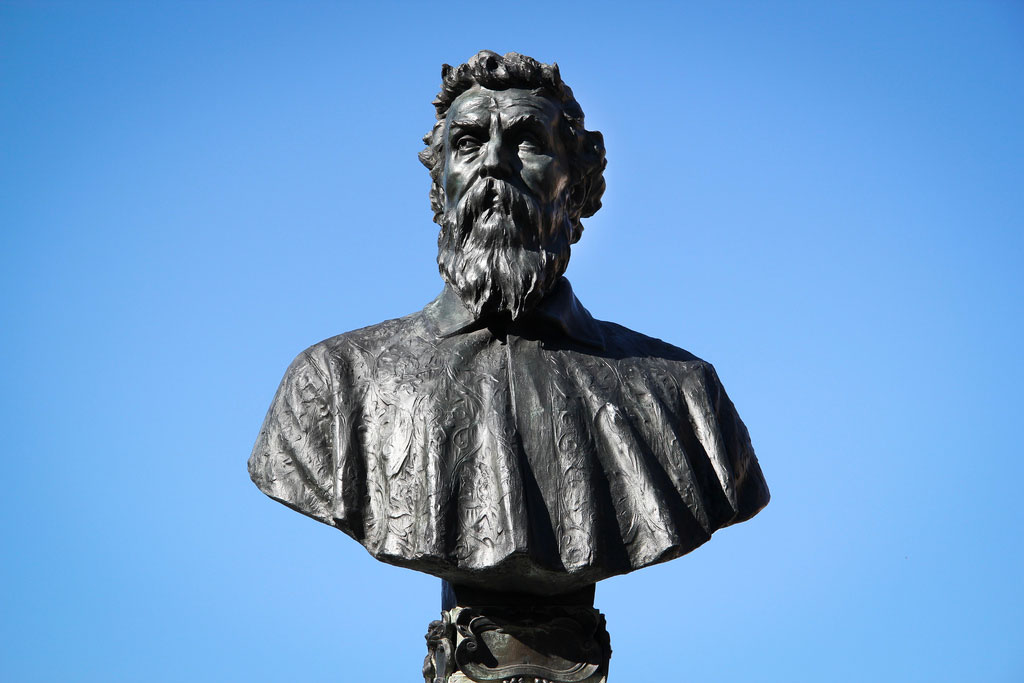RAFFAELLO ROMANELLI (1856 -1928)

Raffaello Romanelli, son of Pasquale, was born in Florence on May 13 1856. From his early childhood he would often be found in his father’s studio, where he aquired the first skills of draughtsmanship. It is the Italian custom from mid-July to September to go the hills or to the sea to avoid the fierce summer heat in the cities. Raffaello’s family spent their summer at Viareggio and here the boy had developed a longing to spend his life in the Navy. Pasquale’s way of dealing with this was to send him to sea on a frigate at the age of fourteen. After a few months Raffaello returned and now made up his mind to enrol
himself at the Academy of Fine Art in Florence. Whilst at the Academy he continued to learn the skills of working marble in his fathers’ studio. In 1876 Raffaello, now aged twenty, won the annual prize for sculpture from the Academy, with a bas-relief of “Jacob and Rachel at the Well”. Shortly after that he won the scholarship for Rome. The next work which attracted much attention to the young sculptor was his statue of the hero of ancient Roma, “Muzio Scevola”. Then Pasquale passed on to Raffaello further portrait busts that had been commissioned by the Demidoff Princes. It was at that time that Raffaello was nominated Professor at the Academy of Fine Art. After the death of his father in 1887, Raffaello took over the studio in Borgo San Fediano, whilst his brother continued the administration of the Gallery on Lungarno Acciaioli. As Pasquale had done for Lorenzo Bartolini, Raffaello then proceeded to complete the unfinished works of his father, Pasquale. In the Studio of San Frediano Raffaello received the illustrious of the day seeking to have their portraits made in marble and in bronze. Soon his fame even surpassed that of his father, both in Italy and internationally. From 1890 Raffaello began to work on very important commissions, making the equestrian monument to Garibaldi in Siena, the monument to Carlo Alberto in Rome, to Donatello in the Church of San Lorenzo in Florence, to Cosimo Ridolfi in Piazza Santo Spirito in Florence and the bust of Benvenuto Cellini which stands in the centre of the famous Ponte Vecchio in Florence. He made the monument to King Carlo I of Roumania, the portrait of Pope Benedetto XV, one of William Penn in Philadelfia, a great monument in Romania at Galatz celebrating the union of Moldavia with Valacchia, the group “Christ and the blind man”, for which he received the Grand Prix at the exhibition of Sant Louis. Raffaello’s production was so vast that from 1894 he had rented a second studio in Santo Spirito. In 1892 he directed the restoration of Ratto delle Sabine by Giambologna performed by the director of the Opificio delle Pietre Dure Edoardo Marchionni, an operation that would be repeated in 1907 for another work by Giambologna, Oceano, of which he would later make a copy in marble to be placed instead of the original one in the Boboli Garden (1911) and then a reproduction of the entire fountain for the garden of the Rockefeller villa in the north of New York. In 1901 he went to St. Petersburg to admire the works of Antonio Canova and Bartolini, and then in Moscow, where he was commissioned busts of opera singers Nikolai Nikolaevič Figner and Medea Mei and that of the dancer Virginia Zucchi. He also worked hard for Romania, becoming the official sculptor of the royal family, making numerous stays and making about forty works. In 1913 Raffaello won the competition out of 142 competitors to make the monument to Tzar Alessandro II, one of the largest monuments in Europe. Raffaello was a tireless worker, besides his monuments and portraits creating numerous small and medium sized works of the most various subject, religious, allegorical, animals. It is thought his production is of more than 2300 works. Raffaello died in 1928, passing on the studio to his son Romano.




